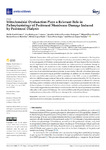Mostrar o rexistro simple do ítem
Mitochondrial Dysfunction Plays a Relevant Role in Pathophysiology of Peritoneal Membrane Damage Induced by Peritoneal Dialysis
| dc.contributor.author | Ramil-Gómez, Olalla | |
| dc.contributor.author | Rodríguez-Carmona, Ana | |
| dc.contributor.author | Fernández-Rodríguez, Jennifer Adriana | |
| dc.contributor.author | Pérez-Fontán, Miguel | |
| dc.contributor.author | Ferreiro-Hermida, Tamara | |
| dc.contributor.author | López Pardo, Mirian | |
| dc.contributor.author | Pérez-López, Teresa | |
| dc.contributor.author | López-Armada, María José | |
| dc.date.accessioned | 2021-03-30T12:09:29Z | |
| dc.date.available | 2021-03-30T12:09:29Z | |
| dc.date.issued | 2021-03-13 | |
| dc.identifier.citation | Ramil-Gómez, O.; Rodríguez-Carmona, A.; Fernández-Rodríguez, J.A.; Pérez-Fontán, M.; Ferreiro-Hermida, T.; López-Pardo, M.; Pérez-López, T.; López-Armada, M.J. Mitochondrial Dysfunction Plays a Relevant Role in Pathophysiology of Peritoneal Membrane Damage Induced by Peritoneal Dialysis. Antioxidants 2021, 10, 447. https://doi.org/10.3390/antiox10030447 | es_ES |
| dc.identifier.issn | 2076-3921 | |
| dc.identifier.uri | http://hdl.handle.net/2183/27648 | |
| dc.description.abstract | [Abstract] Preservation of the peritoneal membrane is an essential determinant of the long-term outcome of peritoneal dialysis (PD). Epithelial-to-mesenchymal transition (EMT) plays a central role in the pathogenesis of PD-related peritoneal membrane injury. We hypothesized that mitochondria may be implicated in the mechanisms that initiate and sustain peritoneal membrane damage in this setting. Hence, we carried out ex vivo studies of effluent-derived human mesothelial cells, which disclosed a significant increase in mitochondrial reactive oxygen species (mtROS) production and a loss of mitochondrial membrane potential in mesothelial cells with a fibroblast phenotype, compared to those preserving an epithelial morphology. In addition, in vitro studies of omentum-derived mesothelial cells identified mtROS as mediators of the EMT process as mitoTEMPO, a selective mtROS scavenger, reduced fibronectin protein expression induced by TGF-ß1. Moreover, we quantified mitochondrial DNA (mtDNA) levels in the supernatant of effluent PD solutions, disclosing a direct correlation with small solute transport characteristics (as estimated from the ratio dialysate/plasma of creatinine at 240 min), and an inverse correlation with peritoneal ultrafiltration. These results suggest that mitochondria are involved in the EMT that human peritoneal mesothelial cells suffer in the course of PD therapy. The level of mtDNA in the effluent dialysate of PD patients could perform as a biomarker of PD-induced damage to the peritoneal membrane. | es_ES |
| dc.description.sponsorship | Instituto de Salud Carlos III; PI15/02218 | es_ES |
| dc.description.sponsorship | Instituto de Salud Carlos III; PI18/01803 | es_ES |
| dc.description.sponsorship | Instituto de Salud Carlos III; AGRUP2015/05 | es_ES |
| dc.description.sponsorship | Instituto de Salud Carlos III; AGRUP2018/03 | es_ES |
| dc.language.iso | eng | es_ES |
| dc.publisher | MDPI | es_ES |
| dc.relation.uri | https://doi.org/10.3390/antiox10030447 | es_ES |
| dc.rights | Atribución 4.0 España | es_ES |
| dc.rights.uri | http://creativecommons.org/licenses/by/4.0/es/ | * |
| dc.subject | Peritoneal dialysis | es_ES |
| dc.subject | Epithelial-to-mesenchymal transition | es_ES |
| dc.subject | Oxidative stress | es_ES |
| dc.subject | Mitochondria | es_ES |
| dc.subject | Mitochondrial DNA | es_ES |
| dc.subject | Biomarker | es_ES |
| dc.subject | Mesothelial cells | es_ES |
| dc.title | Mitochondrial Dysfunction Plays a Relevant Role in Pathophysiology of Peritoneal Membrane Damage Induced by Peritoneal Dialysis | es_ES |
| dc.type | info:eu-repo/semantics/article | es_ES |
| dc.rights.access | info:eu-repo/semantics/openAccess | es_ES |
| UDC.journalTitle | Antioxidants | es_ES |
| UDC.volume | 10 | es_ES |
| UDC.issue | 3 | es_ES |
| UDC.startPage | 447 | es_ES |






